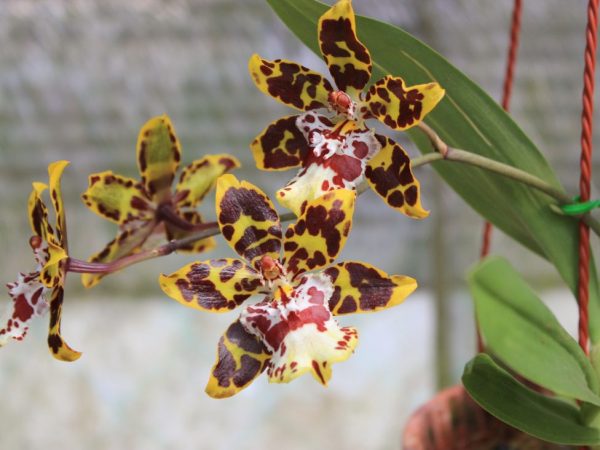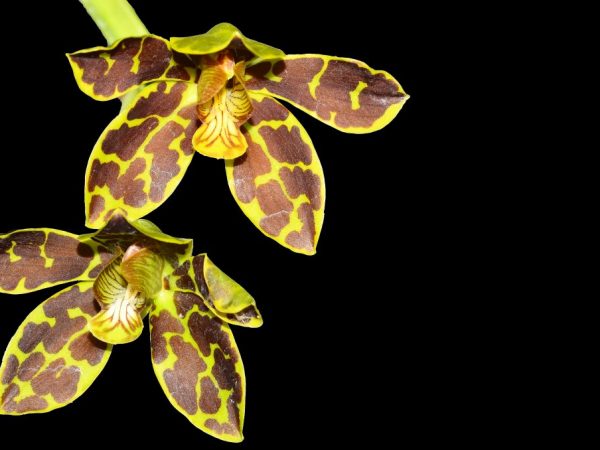Growing a tiger orchid
The tiger orchid is a striking representative of the orchid family of the odontoglossum genus. In natural climatic zones, it grows in the mountain forests of Guatemala and Costa Rica. If you take proper care of the exotic tiger orchid, it is possible to grow it as an ornamental plant at home.

Tiger orchid
Botanical characteristic
The tiger orchid, or odontoglossum large (synonymous with rossioglossum large), is the most famous species of this genus. The foliage of the plant is oblong or broadly lanceolate, wavy, covered with numerous dark brown specks from the bottom.
All representatives of odontoglossums differ in the description of their appearance by the presence of serrated calloused outgrowths located at the base of the lip. Hence the name in translation from the Greek "odons" - a tooth, "glossa" - language.
Peduncle 25-30 cm long, curved, grows from the axils of the lower layer of leaves, usually bears 3-7 large flowers, in rare cases their number reaches 9. Flowers diameter 12-15 cm, formed by lanceolate wavy sepals, the edge of which is bent down ... The color is often bright yellow with large-sized transverse brown stripes. There are varieties with red-brown flowers.
The average duration of the flowering period of large odontoglossum is 1 month. In hot conditions, it decreases significantly.
The lip has a rounded shape, white-cream in color with single red spots or shading. At its base there is a fleshy crest with 2 conical outgrowths in front and 2-4 teeth in the back. The flowering period is September-November.
Microclimate requirements
In the process of caring for a tiger orchid at home, it is required to create a microclimate suitable for the plant.
Illumination
The flower reacts negatively to exposure to direct sunlight. Morning and evening sunlight is allowed. A favorable place for the placement of a large tropical odontoglossum is the window sills to the west and east of the premises. In the summer, the flower is taken out into the open air in a shady place. It is permissible to keep in the open sun from autumn.
Temperature
The temperature regime in the summer season is 15-20 ° С, in the winter period - 10-15 ° С. Significant temperature fluctuations between daytime and nighttime values and a constant supply of fresh air ensure that the plant blooms regularly.

Temperature range for tiger orchid
Humidity
Recommended humidity is 70-80%. When the humidity level drops to a critical level of 40%, the tiger orchid begins to dry out.
At the stage of flower growth, watering is required abundant, at the end of the flowering stage for a dormant period, watering is reduced to a minimum.
An excess of moisture leads to the appearance of spots on foliage and pseudobulbs, followed by decay.
When watering, it is forbidden to use water with high hardness values. The best option for irrigation is a solution of distilled and running water in a 1: 1 ratio.Filtration, boiling and settling help soften the water.
In order to maintain moisture, the plant is sprayed with warm water at a temperature of about 35 ° C. Regular showers increase the amount of young foliage and the frequency of flowering.
Requirements for soil mixture
A soil mixture for growing a tropical flower should contain pine bark, fern roots and charcoal. Coconut chips may be added. Ready-made substrates intended for the orchid family are suitable for growing.
During the growth period, the flower is fed with fertilizer complexes containing nitrogen, phosphorus and potassium. Fertilization frequency is every 2 weeks.
Transplant and reproduction
The transplant is performed if necessary. When the pot becomes too tight for the flower. The transplant period is before or after the flowering stage (spring or autumn). As signs for transplantation, one can consider the appearance of a young shoot 5-8 cm long in a flower, or the decomposition of the substrate by ½.
After transplanting, watering the plants is stopped for 5-7 days.
Large odontoglossum is propagated by:
- by dividing into parts, while each must have 2 pseudobulbs and 1 growth point,
- seeds, this method is rarely resorted to due to poor survival rate and slow development of seedlings.
Conclusion
Tiger orchids require special care, so it will be quite difficult to grow a flower for the first time it is faced with crop production.


